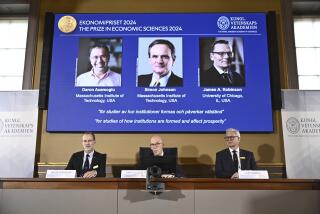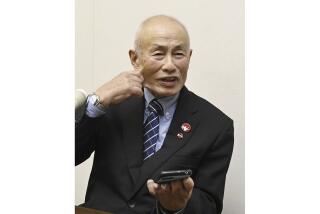Nobel Awarded for Research on Immune System
The 1996 Nobel Prize for physiology or medicine was awarded Monday to two scientists who shed new light on how the immune system battles viruses, ingeniously telling friend from foe as it spares healthy cells but hunts down those that have been invaded.
The recipients, who split the $1.1-million prize, are Peter C. Doherty, 55, an Australian immunologist now working at St. Jude Children’s Research Hospital in Memphis, Tenn., and Swiss research physician Rolf Zinkernagel, 52, of the University of Zurich.
Their joint research, conducted in the mid-1970s at the Australian National University in Canberra, has led to improvements in organ transplantation as well as to new approaches to treating cancer and to developing vaccines against viruses, researchers say. It also offers insight into how the body’s white blood cells, known as T-cells, struggle against the AIDS virus.
The work has “fundamentally changed our understanding of the development and normal function of the immune system,” said the Karolinska Institute in Stockholm, which administers the prizes.
“It’s all very exciting and gratifying,” Doherty said Monday in a telephone press conference. “It took about 10 or 15 years for our ideas to be shown to be correct.” He added: “It’s very satisfying to have had some responsibility for triggering an enormous area of research.”
“Most of us in the field felt this was an award that was coming and it was only a question of when they would get it,” said Dr. Philip Greenberg, an immunologist and cancer specialist at the University of Washington School of Medicine. Greenberg is testing a method of preventing viral infections in cancer patients that is based directly on the Nobel research.
“It changed everything, really,” he said of the research.
“I assume some things will change in my life now,” Zinkernagel told Reuters after hearing he had received science’s most coveted prize. “But we know so little still that there is enough work to keep me busy for the coming years and decades.”
“I’ve had no time to think about what to do with the money,” he added.
Zinkernagel worked for three years at the Scripps Research Institute in La Jolla after leaving Australia in 1975. “He moved very fast and he was aggressive but he did it without running over people,” Scripps immunologist William Weigle recalled of Zinkernagel. “The main thing I can say about him is he is a very perceptive person. He sees things way ahead of others.”
Zinkernagel’s nephew, Lukas Brun, 24, is an economist in Los Angeles. As a boy he visited his uncle in La Jolla, and he recalled a brilliant eccentric roaming the house singing operatic arias at the top of his lungs. “He loves opera, especially Verdi and Vivaldi,” Brun said.
The prize was awarded for research that addressed a fundamental question in biology: How does the immune system tell the difference between the body’s own cells and foreign material like germs, viruses, or even transplanted organs?
In the mid-1970s, Doherty and Zinkernagel conducted a series of experiments showing in unexpected detail how white blood cells known as T-lymphocytes, or T-cells, were able to “recognize” cells that had been invaded by a virus.
After infecting mice with a meningitis virus, they collected the T-cells that had developed in response. The fundamental insight was that although those altered T-cells would kill virus-infected cells from that strain of mouse, the T-cells had much less effect against virus-infected cells from another mouse strain.
In short, the researchers showed that the T-cells were highly specific in their activity and indeed had to recognize two signals on the invaded cell’s surface at the same time to be fully effective: an antigen from the virus and another from the host cell, which would differ slightly from strain to strain.
Because the finding pertained to the basic issue of distinguishing “self” from “nonself,” as researchers say, it has been important in helping to avoid rejection in organ transplants. T-cells are also on the front line of defense against the AIDS virus, and the foundation laid by the new honorees may contribute to better treatments for the disease, said Dr. Anthony Fauci, head of the National Institute of Allergy and Infectious Disease.
It was a “very, very important seminal observation,” Fauci told the Associated Press.
The research also bears on so-called autoimmune diseases like rheumatoid arthritis and non-insulin-dependent diabetes, in which the body’s system for telling self from nonself goes haywire and the immune system attacks the body’s own tissues.
It also suggests new avenues for developing vaccines, and researchers are now focusing on that part of an invading virus that peeks out from a cell and signals T-cells.
“Already it has led to successful vaccines for animals and if one has such a vaccine for animals, then it must not be far away before you can do the same with humans,” Sten Grillner, chairman of the Nobel medicine committee, told Reuters.
The three years that Doherty and Zinkernagel worked together in Australia constitute one of the briefest collaborations to lead to a Nobel Prize, acknowledged Doherty, who added that they now pursue independent projects. At the moment, he said, the two disagree over the question of how the immune system “remembers” to recognize a foreign invader like a virus even if it hasn’t seen the invader in years--a key to how vaccines work.
“We’re in a big debate about that now,” he said. “But we’re still good friends.”
The medicine award is one of six Nobel prizes given each year since 1901 with funds provided by Alfred Nobel, the Swedish scientist who invented dynamite.
(BEGIN TEXT OF INFOBOX / INFOGRAPHIC)
The Discovery
Peter Doherty and Rolf Zinkernagel won the Nobel Prize in medicine for the discovery of how the immune system recognizes virus-infected cells. The discovery gives hope for treatment of cancer and AIDS.
WHAT THEY DID
To fight a virus invasion, the immune system’s T-cells must distinguish between healthy cells and those that harbor a virus. The Nobel Prize-winning research showed for the first time that T-cells simultaneously “recognize” bits of the virus protruding from the cell and from the host cell’s own antigens. That dual signal prompts the T-cell to release compounds that may kill the infected cell.
****
PRIZE CALENDAR
* Literature: Wislawa Szymborska
* Medicine: Peter Doherty and Rolf Zinkernagel
* Economics: To be announced today
* Physics and chemistry: To be announced Thursday
* Peace: To be announced Friday
****
THE WINNERS
Peter Doherty
Age: 55
Nationality: Australian
Current: Department chairman at St. Jude Children’s Research Hospital in Memphis, Tenn.
*
Rolf Zinkernagel
Age: 52
Nationality: Swiss
Current: Head of Zurich University’s immunology institute
More to Read
Sign up for Essential California
The most important California stories and recommendations in your inbox every morning.
You may occasionally receive promotional content from the Los Angeles Times.










